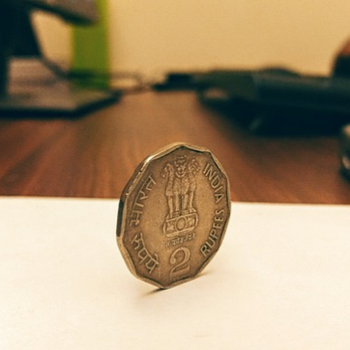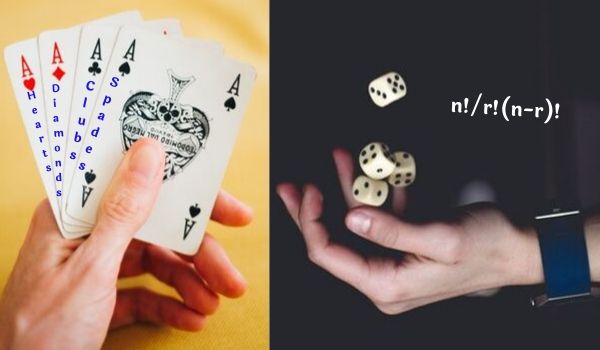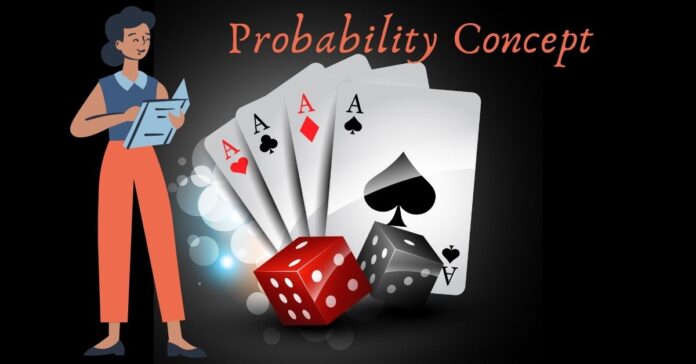The probability concept is frequently used in day-to-day life. In situations like maybe it rains tomorrow, probably I will win this match are some cases of incidents that will happen or not. so the probability is a concept which deals with the measurement of uncertainties.
Here the concept of probability mainly deals with three kinds of situations.
1. Tossing coin (or) rolling die
2. Gambling with cards
3. The number of combinations of objects.
These are the basic concepts in probability around which questions are asked. Let’s understand these three situations…
Tossing Coin or Rolling Die in Probability Concept
Coin


A coin consists of two faces Heads and Tails. When a coin is tossed events of happening head or tail prevents occurring of event of tails or heads respectively.
so, when a coin is tossed
The total number of outcomes is 2.
The event of the happening of heads or tails is 1.
Die
A die consists of ‘6’ faces numbered or dotted on each face individually as 1, 2, 3, 4, 5, and 6 (or) with dots.
When a die is thrown the possible number of outcomes is 6.
When two dies are thrown it is 62
For 3 dies it is 63 . Like this, it goes on


Gambling with Cards in Probability concept
A pack or deck of playing cards contains 52 cards. These 52 cards are categorized into 4 suits.
1. Hearts
2. Diamonds
3. Spades
4. Clubs
And again these 4 suits contain 13 cards individually in each of the suits.
These 13 cards contain one Ace, (2 to 10) numbered cards, one jack, one queen and one king for each suit.
Number of Combinations of Objects in Probability Concept
Consider ‘n’ objects taken ‘r’ at a time where (r ≤ n) then number of combinations is given by C(n,r) or ncr .
\begin{align*}
n_{C_{r}}=\dfrac {n!}{\left( n-1\right) !r !} \\ \\ = \dfrac {n\left( n-1\right) \left( n-2\right) \ldots \left( n-r+1\right) }{r\left( r-1\right) \left( r-2\right) \ldots 3\cdot 2\cdot 1}
\end{align*}
Here nc0=1 ncn =1
Some basic terms in Probability Concept
Trial (or) Experiment
Performing of an experiment is called a Trial.
Example:
1. Tossing a coin
2. Throwing a die
Event
It is a possible outcome of an experiment or trial.
Example:
- When a coin is tossed, occurring of the head is an event with the head as an outcome.
- Similarly occuring of the tail is also an event with a tail as an outcome.
- When throwing a die possibility of outcomes 1 or 2 or 3 or 4 or 5 or 6 is also an event.
What is Probability?
Let E be an event
The probability of an event P(E) is defined as the number of times the event achieved is successfully divided by the total number of possible outcomes.
\begin{align*}
P\left( E\right) =\dfrac {\begin{pmatrix} Number \ of \ times \\ event \ achieved \end{pmatrix}}{\begin{pmatrix} Total \ number \ of \\ possible \ outcomes \end{pmatrix}}\end{align*}
Example:
Let us consider tossing a coin. Find the probability of occurring heads as an event.
Solution:
When a coin is tossed its outcome may have events heads or tails.
so, the total number of possible outcomes =2
heads may occur only once so, number of times event occurs =1
∴ P(E)= ½
Sample Space
It is the total number of outcomes that occur when a trial is done and is denoted by S.
For tossing a coin S={head, tail}
similarly for die is thrown S={1, 2, 3, 4, 5, 6}
NOTE:
- When a coin is tossed occurring of outcomes is likely to be equal in all trials. [heads or trials]
- Similarly when a die is thrown it also has equally likely outcomes.[1, 2, 3, 4, 5&6]
Simple and Compound Events
In a simple event, we consider the probability of occurring or not occurring in a single event.
Example question of probability on cards
What is the probability of drawing a king spade card from a pack of cards?
Solution:
As we have 52 cards
The total number of possible ways of drawing a card is 52.
Number of ways of drawing King spade card = 1
Probability of event occurring P(E)
\begin{align*}
P\left( E\right) =\dfrac {\begin{pmatrix} Exact \ Number \ of \ times \\ king \ spade \ card \ drawn \end{pmatrix}}{\begin{pmatrix} Total \ number \ of \ cards \\ can \ be \ drawn \ from \ pack \end{pmatrix}}\end{align*}
\begin{align*}= \dfrac{1}{2}
\end{align*}
In compound events, we consider the probability of occurring or non-occurring of two events or more events at a time.
Example Probability question on balls
If fro a bag containing 8 blue &5 green balls two successive draws of 2 balls are made without replacement. Then what is the probability of getting 2 blue balls in the first draw and 2 green balls in the second draw?
Solution:
Since the bag contains 8 blue balls & 5 green balls
Total number of balls in bag =13
The favorable case of the first draw is 2 balls from 8 balls.
Probability in the first case ( P1 )= 8c2 / 13c2
After this incident the total number of balls in the bag are 13-2=11
In the second case drawing of 2 green balls from 5 green balls is made.
Probability in the second case ( P2 )= 5c2 / 11c2
Both events are independent therefore total probability= P1 × P2
⇒ ( 8c2 / 13c2 ) × ( 5c2 / 11c2 )
Exclusive Events
If the occurrence of one event resists or rules out the occurrence of another event in the same experiment is a mutually exclusive event.
Example:
When a coin is tossed events of heads resist the event of tails. Here both head & tail cannot occur at the same time. so, they are mutually exclusive events.
Independent Events
Two events A and B are said to be independent events if the probability of occurrence of one event (A) does not affect the probability of occurrence of another event (B).
Example:
When two coins are tossed simultaneously so the occurrence of tails on the first coin does not affect the occurrence of heads on another coin.
Thus, they are independent events.
The probability of two independent events is P(A & B)=P(A) × P(B)
Algebra of Events in Probability Concept
Consider A and Y as events within sample space (S) then,
| Algebra Notation | Probability Representation |
| A∪Y | Either event A or Y or both happen |
| A∩Y | Event A and Y both happen simultaneously |
| Ā | Event A does not happen |
| Ȳ | Event Y does not happen |
| Ā∩Ȳ | Event of non-occurance of both A and Y |
Rules of Probability
In a random experiment let E and F be the events and ‘S’ be sample space.
- The probability of an event is always considered to be lie between 0 and 1. (0≤P(E)≤1)
- The probability of the sum of all the elementary events of a trial is always equal to 1.
- The probability of occurrence of an impossible event is ‘0’.
Example:
When a die is thrown its outcomes are {1, 2, 3, 4, 5, and 6}
The event of the occurrence of ‘8’ is not possible.
so, the probability of occurrence of event ‘8’ is impossible when a die is thrown. - For sure event probability is ‘1’.
Example:
When a die is thrown its outcomes are {1, 2, 3, 4, 5, and 6}
For a die-thrown event to happening a number less than ‘7’ can be achieved in 6 ways.
Its total outcomes are 6
∴ Probability of occurrence of the event less than 7 = 6/6 =1
Thus, the probability of an event that is sure to occur is ‘1’. - P(Ē)=1-P(E)
Here Ē is the complementary event of ‘E’. - P(E∪F)=P(E)+P(F)-P(E∩F)
- P(E-F)=P(E)-P(E∩F)







